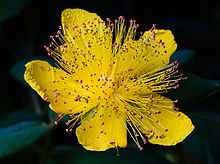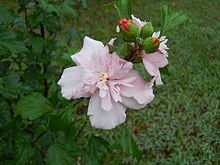Rose of Sharon
Rose of Sharon is a common name, a biblical name, that has been applied to several different species of flowering plants that are valued in different parts of the world. The name's colloquial application has been used as an example of the lack of precision of common names, which can potentially cause confusion.[1] "Rose of Sharon" has also become a frequently used catch phrase in lyrics and verse.
Biblical origins
The name "rose of Sharon" first appears in English in 1611 in the King James Version of the Bible. Varying scholars have suggested that the biblical "rose of Sharon" may be one of the following plants:
- A kind of crocus ("Sharon", Harper's Bible Dictionary) or a crocus that grows in the coastal plain of Sharon (New Oxford Annotated Bible);
- Tulipa montana, "a bright red tulip-like flower ... today prolific in the hills of Sharon" ("rose", Harper's Bible Dictionary);
- Tulipa agenensis, the Sharon tulip, a species of tulip suggested by a few botanists
- Lilium candidum, more commonly known as the Madonna lily, a species of lily suggested by some botanists, though likely in reference to the lilies of the valley mentioned in the second part of Song of Solomon 2.1.
- Narcissus[2]
According to an annotation of Song of Solomon 2:1 by the translation committee of the New Revised Standard Version, "Rose of Sharon" is a mistranslation of a more general Hebrew word for crocus.
Chavatzelet HaSharon (Hebrew חבצלת השרון) is an onion-like flower bulb. The Hebrew חבצלת (ḥăḇaṣṣeleṯ) is a flower of uncertain identity translated as the rose of Sharon in English language translations of the Bible. Etymologists have tentatively linked the biblical חבצלת to the words בצל beṣel, meaning 'bulb', and חמץ ḥāmaṣ, which is understood as meaning either 'pungent' or 'splendid' (The Analytical Hebrew and Chaldee Lexicon).
A likely interpretation for the Biblical reference is Pancratium maritimum, which blooms in the late summer just above the high-tide mark. The Hebrew name for this flower is חבצלת or חבצלת החוף (coastal ḥăḇaṣṣeleṯ). Since the flower grows on the Sharon Plain of the coast of the Mediterranean Sea, it is possible the Biblical passage refers to this flower.
Recently, some scholars insist on translating ḥăḇaṣṣeleṯ into "a budding bulb" in consideration of the genealogical research of multilingual versions and lexicons.[3]
Modern usage


The name "Rose of Sharon" is also commonly applied to two different plants originating outside the Levant and not likely to have been the plant from the Bible:
- Hypericum calycinum, an evergreen flowering shrub native to southeast Europe and southwest Asia
- Hibiscus syriacus, a deciduous flowering shrub native to east Asia
In Art and Literature
- "The Rose of Sharon" is one name used for the infant Christ by English poet Robert Herrick (1591–1674) in his poem "To His Saviour, a Child: A Present by a Child." Herrick presumably borrowed the term from King James Version of the Bible and other contemporary sources. The child to whom the poem is addressed offers two gifts to the baby Jesus: a flower in full bloom ("...bear this flower / Unto thy little Saviour; / And tell Him, by that bud now blown, / He is the Rose of Sharon known...") and a reed whistle. Musical settings of the poem include Betty Roe's "To his sweet saviour," a song for countertenor and harpsichord, and Jack M. Jarrett's choral work "Go, Pretty Child."
Rose of Sharon is also the name of Ma and Pa Joad's daughter in Grapes of Wrath, by John Steinbeck.
Popular culture
- Rose of Sharon (Hibiscus syriacus) is the national flower of South Korea. The first record of the Rose of Sharon (mugunghwa: 무궁화) grown in Korea is mentioned in an article produced 1,400 years ago. A mythological fiction, Xuanzhongji (Hanja:玄中記), written in the Eastern Jin Dynasty (Hanja:東晉) of China, mentions "The Land of Wisemen is spread for 1,000 li where mugungwha flowers bloom plentifully"(君子之國,地方千里,多木槿之華). The name "mugungwha" was first used by the poet Lee Gyu-bo (이규보,1168 – 1241) of the Goryeo Dynasty.
- In the USA, the 'White Rose of Sharon' is the official flower of Phi Beta Chi, a national Lutheran-based Greek social letter sorority.
- In Canada, Rose of Sharon is a charity that focuses on helping pregnant and parenting young women under the age of 25.[4]
- In The Grapes of Wrath by John Steinbeck, Rose of Sharon (often called "Rosasharn") is a major character, the eldest daughter of the Joad family and the sister of the protagonist Tom Joad. In nature the Rose of Sharon was found to survive the adverse conditions of the Dust Bowl just like Steinbeck's character.
- Leonard Bernstein's Kaddish Symphony takes the form of a monologue by a narrator self-identified as Chavatzelet HaSharon, "the lily that man has picked and thrown away."
- The Rose of Sharon is referenced in the Bob Dylan song "Caribbean Wind." The song appeared on the compilation album Biograph but was originally recorded during the sessions for Shot of Love.
- The song "King's Ransom" from the 1986 Petra album Back to the Street contains a lyric in which the Rose of Sharon symbolizes Jesus Christ.
- The song "Rose of Sharon" is on the 1991 Camel album Dust and Dreams
- The Rose of Sharon is also referenced in the Kate Bush recording "The Song of Solomon" from her 1993 album The Red Shoes.
- The Rose of Sharon is referenced in the Killswitch Engage song "Rose of Sharyn" from their 2004 album The End of Heartache.
- There is a song entitled "Rose of Sharon" on Xiu Xiu's 2005 album La Forêt. The lyrics seem to allude to both the Song of Solomon and to Steinbeck's novel.
- The Ragnarok Online background music set includes a track called "Rose of Sharon".
- The village of Rosharon, Texas is named after the "Rose Of Sharon" from the Cherokee Roses that grew nearby.
- Leonard Cohen in his original poem The Traitor (on which the song "The Traitor" is based) also refers to the Rose of Sharon.
- Rose of Sharon is a homeless character in Sherman Alexie's short story What You Pawn I Will Redeem, published April 21, 2003 in The New Yorker.
- In Brazil, Rosa de Saron (Portuguese for Rose of Sharon) is the name of a well-known white rock group, that has include recorded some songs in English.
- Sephardic Hebrew poetry from the 10th-15th century demonstrates prolific use of the חבצלת (ḥăḇaṣṣeleṯ) translated into English consistently as "Rose of Sharon"; there are a few renderings as "lily" (see Gate 47 of the Tahkemoni) .[5] The term and trope are found throughout the Sefer Tahkemoni by Yehuda Alharizi (1165–1225) and much of the poetic corpus of the Golden Age of Iberian Jewish belles lettres, which includes the works of such poets as Shmu'el HaNagid (993-1056), Moses Ibn Ezra (c.1055-after 1138), Yehuda Halevi (c.1075-1141), and Abraham Ibn Ezra (c.1093-c.1167) among others.[6]
- Judah Robertson has an album entitled Rose of Sharon.
- "Rose of Sharon" is a song by Robert Hunter (Grateful Dead) released on his solo album Tiger Rose.
- "Rose of Sharon" is a song written and performed by Eliza Gilkyson on her 1997 album Redemption Road.
- "Rose of Sharon" is a song sung by Joan Baez on the album Day After Tomorrow.
- Rose of Sharon Cassidy is a character in the video game Fallout: New Vegas. She implies she is named after the Steinbeck character.
- "Rose of Sharon" muttered by the character Just the Job in Maxim Gorky's My Childhood.
- Shoshanat HaAmakim, a communal settlement in central Israel.
- Rose of Sharon is a song on Title Fight's 2015 album Hyperview
References
- ↑ Botanic Gardens Trust, Sydney, Australia: Why use a scientific name?
- ↑ McClintock, John; Strong, James (1889). "Rose". Cyclopaedia of Biblical, Theological, and Ecclesiastical Literature, Vol. IX RH-ST. New York: Harper & Brothers. p. 128. Retrieved 8 October 2014.
- ↑ Satoshi Mizota. Origin of 'Rose of Sharon' : An Analysis of Various Translations Having a Bearing on The Authorized Version Text. Dissertation for MA: Aich University, 2008.
- ↑ "Rose of Sharon: Services for Young Mothers". Archived from the original on June 9, 2008.
- ↑ Alharizi, Judah. The Book of Tahkemoni, Translation: David Simha Segal. The Littman Library of Jewish Civilization, London. 2001
- ↑ Cole, Peter. The Dream of the Poem. Translation: Peter Cole. Princeton University Press, Princeton. 2007
Works cited
- Crawford, P. L. (1995). "Rose". In Paul J. Achtemeier (gen. ed.). Harper's Bible Dictionary. San Francisco: Harper. p. 884.
- Davidson, Benjamin (1978) [1848]. The Analytical Hebrew and Chaldee Lexicon (1st softcover ed. ed.). Grand Rapids, Michigan: Zondervan. p. 246. ISBN 0-310-39891-6.
- Lapp, N. L. (1985). "Sharon". In Paul J. Achtemeier (gen. ed.). Harper's Bible Dictionary. San Francisco: Harper. pp. 933–4.
- Scott, R. B. Y. (1991). "Annotations to Song of Solomon". The New Oxford Annotated Bible. New York: Oxford University Press. pp. 854 OT.